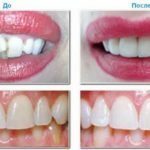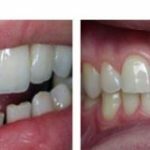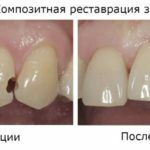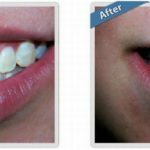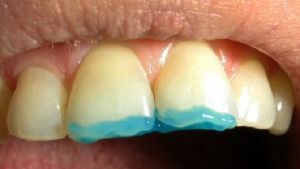 Restoration of teeth includes a number of manipulations aimed at restoring external dental data and its functional capabilities.
Restoration of teeth includes a number of manipulations aimed at restoring external dental data and its functional capabilities.
Composite restoration allows you to achieve significant success in recreating the ideal tooth surface. Photopolymer materials are able to transform teeth and change not only their color, but also their shape. Thanks to the latest developments, dentists have the opportunity to hide or make less visible some defects in the dentition.
Content of
- Someone will do, but some do not have
- Materials and methods of restoration
- Stages of photopolymer reconstruction
- Restoration of anterior teeth
- Restoration of teeth of chewing group
- Advantages and disadvantages of using photopolymers
- Satisfied girls = beautiful teeth
Someone will do, butSome do not have
Indications for restoration by photo-composites:
- enamel damage( chips and cracks);
- restoration of aesthetic appearance of the dentition( correction of hue and tooth shape);
- formation of carious cavities and partial destruction of the tooth surface;
- slight defects in the dentition and the gap between the teeth;
- wrong position of the teeth.
Contraindications to restoration of teeth with the help of a composite can serve:
- severe gingival inflammation;
- extensive area of caries lesion;
- manifestation of allergic reactions to formulations and materials;
- absence of several chewing teeth;
- bruxism( dental scraping);
- poor oral hygiene.

Materials and methods of restoration
Restoration of teeth with a composite material is done by a direct method. As materials used to recreate the correct anatomical shape of the tooth, heliocomposites, compomers and nanocomposites are used.
This method is used for small deviations from the norm, since it does not take much time from the patient. In the ideal course of events, the restoration, together with the preliminary preparation of the enamel, will take no more than an hour. Tabs are an excellent way of reconstruction. 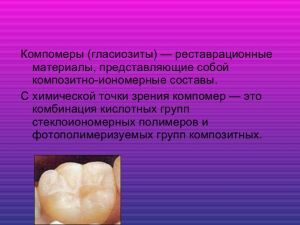
Strongly broken teeth can be restored with pins, a solid base of which will be the ideal foundation for the formation of the masticatory surface. A variety of metal compounds, as well as titanium, brass, fiberglass and ceramics, serve as the material for making the pins.
Such structures are fixed in the root canal and in combination with the photopolymer materials applied on them can fully replace the missing volumes.
Indirect method in composite restoration is not applied, because photopolymer veneers are formed directly during the restoration and immediately fixed on the teeth. In modern dental practice, such veneers are practically not used. They were replaced by more durable and aesthetic lining.
Stages of photopolymer reconstruction
Stages of restoration with composites:
- professional teeth cleaning, in order to ensure that the adhesion of the material to the enamel is strong, it is necessary to remove all accumulated plaque from the tooth surface and also to clean it of stones;
- removal of previously installed seals;
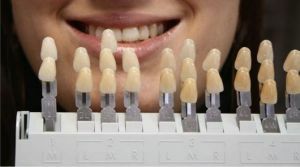
- selection of a shade corresponding to the natural color of the teeth;
- local anesthesia is performed;
- drill and clean up areas damaged by caries;
- isolation of the tooth surface from saliva;
- treatment of enamel with special compounds that degrease it and kill all microbes;
- layer-by-layer application of composite material with mandatory drying of each layer with a special lamp;
- corrective work and grinding.
Restoration of the front teeth
The general perception of the person around people depends on the condition and appearance of the teeth in the "smile zone".A beautiful and even dentition certainly looks more attractive.
Amalgam and cement fillings have lost their popularity for a long time due to their features, while a few neatly applied photopolymer layers are able to give the restored tooth quite a decent appearance.
Frontal teeth require closer attention of the doctor, so a visit to the dentist may take some time. To install the pin, the patient will need to visit the specialist several times. After the tooth takes its place in the oral cavity, it will require additional control over its "adaptation" in the jaw.
In addition to all these nuances, the patient has every right to contact his doctor for any discomfort. In some cases, the dentist may decide to adjust the shape of the tooth surface, formed with an individually selected composite composition.
Restoration of the teeth of the chewing group
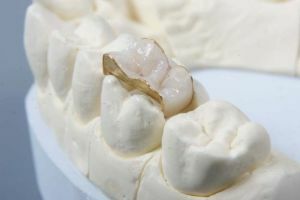 In addition to the usual application of filling materials, pin structures are used to restore the full functionality of the tooth row. Thanks to this method of correction, a doctor can grow a tooth that lacks more than 50% of the crown part.
In addition to the usual application of filling materials, pin structures are used to restore the full functionality of the tooth row. Thanks to this method of correction, a doctor can grow a tooth that lacks more than 50% of the crown part.
A correctly fixed pin in the root canal provides a reliable support for the restored tooth and helps it to cope with the masticatory load.
This process is carried out in several stages, since the dentist must take into account all the factors and conduct a complete examination of the condition of the periodontal tissues.
Advantages and disadvantages of using photopolymers
One of the main advantages of composite expansion is the minimal processing of the tooth surface. Neighboring teeth remain unchanged and do not require turning.
This method of recovery is in an affordable price category, so patients can get all the necessary medical care for a fairly moderate fee. Photopolymer materials allow you to quickly and with minimal impact on the tooth return the enamel its original shade. In addition, for corrective procedures will not take too long.
Despite a lot of positive moments, the use of composite compositions still has some drawbacks. Over time, they lose their original color, darken and too clearly stand out against the background of the rest of the teeth.
Of course, for the teeth of the chewing group this is not so important, because they are in the depth of the mouth. But because of insufficient margin fit, the risk of caries is increased.
Photopolymer seals have one more significant drawback: they wear off and gradually lose shape. Therefore, already in 3-4 years after installation the patient will have to think about the re-restoration.
Satisfied girls = beautiful teeth
Reviews of girls who have been restorated teeth composite material.
From childhood, I was embarrassed by my teeth, so the smile on my face was rare. My clumsy teeth prevented me not only at school, but also at the institute.
Having got a job, I decided that it's time to finish this and chose a composite recovery. Only one ukolchik, one and a half hours of patience - and you're done! Now you can not see a single blackened area, and the teeth themselves, of course, are not perfect, but they become much smoother.
Maria, 30
I had a few ugly seals on my front teeth. Before the adolescence, it did not really bother me, but when I started dating boys, the question arose.
But I decided on art restoration only in 25 years. The dentist removed all the old fillings, polished the tooth enamel and applied a special composition in several layers. Now my teeth look just fine!
Elena, 26
The cost of composite restoration depends not only on the materials selected, but also on the number of teeth to be restored. The minimum price for this type of service is 3000 rubles, and the maximum price is over 10,000.

